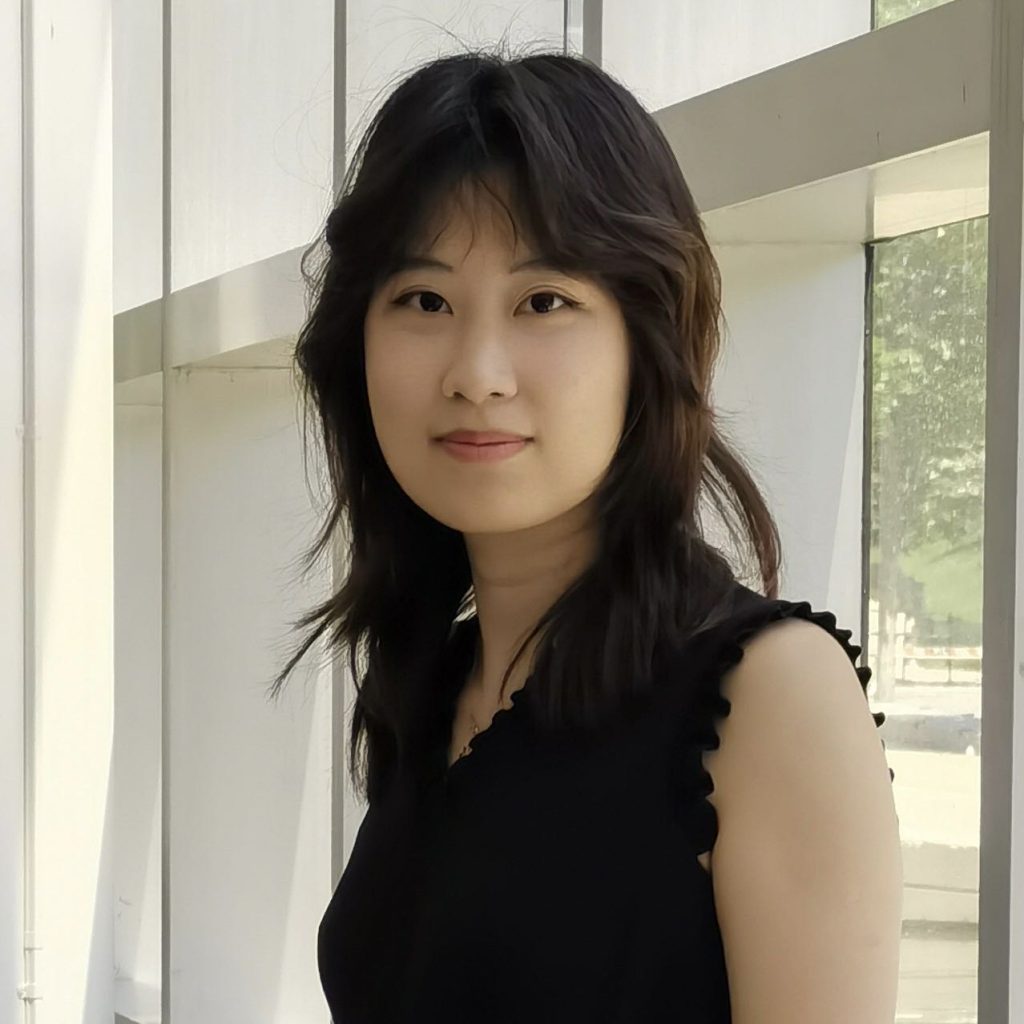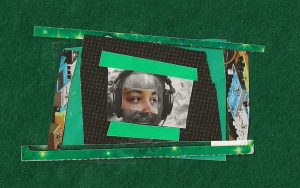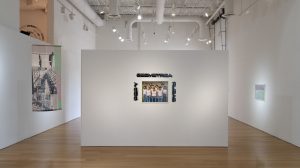Several years ago, my friend and I were sitting in a piano room and talking about the differences between various musical instruments. We felt that the piano appeared more like a complicated machine than others. This mysterious black box holds ingenious devices that transfer the pressing of individual keys to different notes. When I saw Qianwen Yu’s project Woven Symphony at the 6th Midwest Open in Woman Made Gallery this fall [fig.1], the analogy between loom and piano aroused my memories of that conversation. The work points out the similar aesthetics in the process of weaving and music composing, both realized by the vibration and arrangement of strings
Woven Symphony is composed of seven music pieces based on seven different weaving patterns of an 8-shaft floor loom. Viewers listen to the music by using a headphone linked to an iMac displaying a corresponding weaving pattern—such as a cute teddy bear [fig.2], a vibrant tree, or shining stars— which serves as the score of each music piece. Qianwen assigns numbers 1-8 to different columns in the weaving draft, which represent eight musical notes in the C major scale (do, re, mi, fa, sol, la, ti, do). Through music composing software, the artist picks an instrument to play several rows at a time from the bottom to the upper part of the pattern [fig.3], the same direction for the weaving process. In this way, a unique melody was created. With the help of musician Bryan Away, Qianwen also experiments with the layering of different patterns together; thus each weaving pattern becomes an instrument to construct a grand symphony.
I used to consider weaving and music as separate fields, for I always assume that viewing and hearing create independent sensations. However, Qianwen’s music pieces tie together auditory and visual sensations, creating unprecedented experiences for me. For the “teddy bear,” when I follow the rows in the pattern for the bass clarinet, I imagine the energetic movement of a clumsy bear. The harp performs one row at a time in the “tree,” depicting the slow growing process of multiple layers of thriving branches and leaves. The marimba in the “heart” traces the curved shape of the pattern, creating a crispy and bright rhythm like the leap of one’s heart. Combined with the sound, the static symbol in the weaving draft becomes vivid in my mind throughout the time.
I am curious to know why the artist chose to intertwine these two creative areas. The answer lies in Qianwen’s research essay “Exploring the Parallels Between Weaving and Music” beside her artwork, which unfolds the interrelated history between weaving and music production, art and technology. Jacquard loom [fig.4], a machine that automates the process of manufacturing complex textiles, has inspired the invention of pianola (self-playing piano), even laying the foundation of future computer programming. To use the Jacquard loom, weavers translate the design patterns on a series of punched cards linked to the loom, similar to the music roll paper spinning in the pianola [fig.5]. The holes on cardboard for the Jacquard loom allow certain threads to pass through, while those on music roll paper change the air pressure, allowing different keys to be played according to how much air is coming through.
Weaving and music production share striking resemblances. More than once have I opened the lid of a piano (not to mention other string instruments), and those parallel strings appear like the warp (vertical) threads set on a loom. Both machines require the operator’s eyes, hands, and feet to manipulate and weave/compose the ultimate product throughout the time. Repetition and variation of patterns (motifs) in weaving (playing music) form a rhythm through the sequential actions. The five horizontal lines and the music notes in the staff (Western music notation) are also visually similar to the interlaced warp (vertical) and weft (horizontal) threads that constitute the woven fabric.
It seems to me that weaving and music composing demonstrate an interesting duality in the making of art forms. A musician causes different strings to vibrate and creates sound waves in the air, to which the audience pays more attention than the fixed pattern on the staff. The weaver guides different threads to cross each other and form a pattern. Viewers pay attention to the ultimate graphic patterns rather than the sound of the loom or the weaver’s action during the process. Woven Symphony critically demonstrates the possibilities of artistic creation—the motif in sound can be both heard and seen, and a weaving pattern can extend in time rather than being trapped by the gaze.
With the intention to bridge the sensory gap between weaving and music, Woven Symphony reminded me of the concept of “string theory.” It is a hypothetical theory assuming all particles in the world are formed by the vibration of one-dimensional objects called “strings” at different frequencies. Though the “string” in physics are totally different from the strings in musical instruments and looms. It is fascinating to realize that weaving and music are both generated by oscillation of strings. String theory is constructed with the hope to subsume general relativity and quantum mechanics into a broader framework. Likewise, Woven Symphony can be viewed as an experimental practice to reconcile two disparate fields and provoke cross-disciplinary thinking. One can thus hear the dance of textile and enjoy the vision of melodies.
Further reading: “Exploring the Parallels Between Weaving and Music” by Qianwen Yu.

About the author: Yunyao Que is a writer, curator, and art administrator born in Shanghai and now based in Chicago. She recently made a wooden box named “Suitcase” as a portable exhibition to show works made by six artists about travel and migration. Yunyao loves oceans, land arts, connections, and imagination.
![Image: [Fig. 1] On-site view of “Woven Symphony” at Woman Made Gallery; a person wearing headphones stands at in front of a white plinth looking at a computer monitor with a white and black grid pattern in the center of it. Photo by Qianwen Yu.](https://sixtyinchesfromcenter.org/wp-content/uploads/2023/12/cover-image.png)


